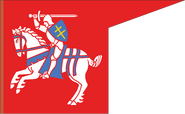(Template fixes; table to gallery; category) |
m (→Other Lithuanian flags: Moving easter egg links to captions using AWB) |
||
| (One intermediate revision by the same user not shown) | |||
| Line 4: | Line 4: | ||
|image = Flag of Lithuania.svg |
|image = Flag of Lithuania.svg |
||
|designer = Antanas Žmuidzinavičius |
|designer = Antanas Žmuidzinavičius |
||
| − | |adoption = 25 April 1918<br/>20 March 1989 (re-adopted) |
+ | |adoption = 25 April 1918<br/>20 March 1989 (re-adopted)<br/>8 July 2004 (modifications made) |
|image2 = 1418px-Flag of Lithuania (state).svg.png |
|image2 = 1418px-Flag of Lithuania (state).svg.png |
||
|caption2 = State flag of Lithuania |
|caption2 = State flag of Lithuania |
||
| Line 63: | Line 63: | ||
== Other Lithuanian flags == |
== Other Lithuanian flags == |
||
| − | <gallery orientation="none" |
+ | <gallery orientation="none" > |
1200px-Flag_of_Lithuania_Minor.svg.png|Flag of Lithuania Minor |
1200px-Flag_of_Lithuania_Minor.svg.png|Flag of Lithuania Minor |
||
1440px-Flag_of_the_President_of_Lithuania.svg.png|Standard of the President of Lithuania |
1440px-Flag_of_the_President_of_Lithuania.svg.png|Standard of the President of Lithuania |
||
Flag_of_Samogitia.svg.png|Historic flag of Samogitia |
Flag_of_Samogitia.svg.png|Historic flag of Samogitia |
||
| − | Flag_of_the_Lithuanian_Army.svg.png|Flag of the Lithuanian Army with Columns of Gediminas |
+ | Flag_of_the_Lithuanian_Army.svg.png|Flag of the Lithuanian Army with {{w|Columns of Gediminas}} |
Naval_Jack_of_Lithuania_(1992-2004).svg.png|Naval Jack of Lithuania (1992-2004) |
Naval_Jack_of_Lithuania_(1992-2004).svg.png|Naval Jack of Lithuania (1992-2004) |
||
1600px-Air_Force_Ensign_of_Lithuania.svg.png|Air Force Ensign of Lithuania |
1600px-Air_Force_Ensign_of_Lithuania.svg.png|Air Force Ensign of Lithuania |
||
Revision as of 15:38, 13 December 2019
| This page uses Creative Commons licensed content from Wikipedia. (view authors) |

Flag of Lithuania on top of Vilnius Castle Complex (author: Kaihsu Tai)
The flag of Lithuania (Lithuanian: Lietuvos vėliava) consists of a horizontal tricolor of yellow, green, and red. It was adopted on 25 April 1918 during Lithuania's first period of independence (in the 20th century) from 1918 to 1940, which ceased with the occupation first by Soviet Russia and Lithuania's annexation into the Soviet Union, and then by Nazi Germany (1941–1944). During the post-World War II Soviet occupation, from 1945 until 1989, the Soviet Lithuanian flag consisted first of a generic red Soviet flag with the name of the republic, then changed to the red flag with white and green bars at the bottom.
The flag was then re-adopted on 20 March 1989, almost a year before the re-establishment of Lithuania's independence and almost three years before the collapse of the Soviet Union. The last alteration to the current flag occurred in 2004, when the aspect ratio changed from 1:2 to 3:5.
History
The earliest known flags with a Lithuanian identity were recorded in the 15th-century Banderia Prutenorum, written by Jan Długosz. At the Battle of Grunwald in 1410, two distinct flags were present. The majority of the 40 regiments carried a red banner depicting a mounted knight in pursuit. This flag, known as the Vytis, would eventually be used as the Lithuanian war flag, and again in 2004 as the state flag. The remainder of the regiments carried a red banner displaying the Columns of Gediminas. Those that bore the Vytis, also known as the Pahonia, were armies from the Grand Duchy of Lithuania, while those who bore the Columns of Gediminas were from noble families of Lithuania. Until the end of the 18th century, when it was annexed by the Russian Empire, the Grand Duchy of Lithuania used the Vytis as its flag.
Official colors
| Yellow | Green | Red[1] | |
|---|---|---|---|
| Pantone | 15-0955 TP/1235 C/U | 19-6026 TP/349 C/U | 19-1664 TP/180 C/U |
| RGB | 253–185-19 | 0-106-68 | 193-39-45 |
| CMYK | 0-30-100-0 | 100-55-100-0 | 25-100-100-0 |
| Hex | #FDB913 | #006A44 | #C1272D |
The yellow-green-red stripes of this flag were attributed symbolism relating to the national traditions of the Lithuanian people. Ripening wheat and freedom from want are suggested by the yellow, and green is for hope and the forests of the nation. Red stands for love of country, for sovereignty, and for the courage and valour that keep the flame of liberty burning.[2]
Other Lithuanian flags
Highlands??
Similar flags
The adoption of the current flag of Myanmar in 2010 caused controversial reactions in Lithuania. Then-Prime Minister of Lithuania Andrius Kubilius said: "There are similar flags, take a look at Scandinavian example - there are lots of similarities. So I doubt whether we will express any copyright claims, we don't have any star. We had stars and we don't need then anymore."
Flag proposals
See also
- Gladly unpopular proposals (cringe alert)
- One of the official links (in English)
- Nordic cross proposal for Lithuanian flag
Wikipedia links:
References
- ↑ The color red is described in Lithuanian as "purpuro", which means "purple". However, that doesn't mean the flag color itself is purple. This error was made in regard to the Presidential Standard in early reports by vexillologist publications.
- ↑ https://www.britannica.com/topic/flag-of-Lithuania
























